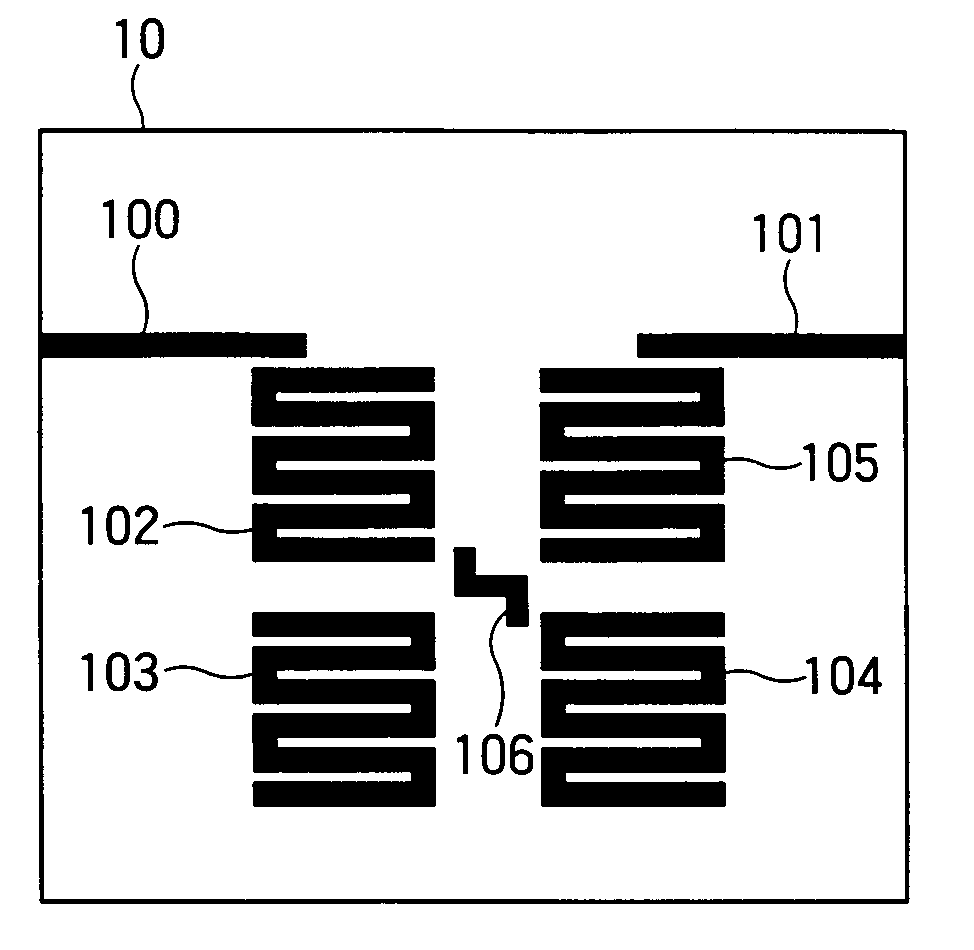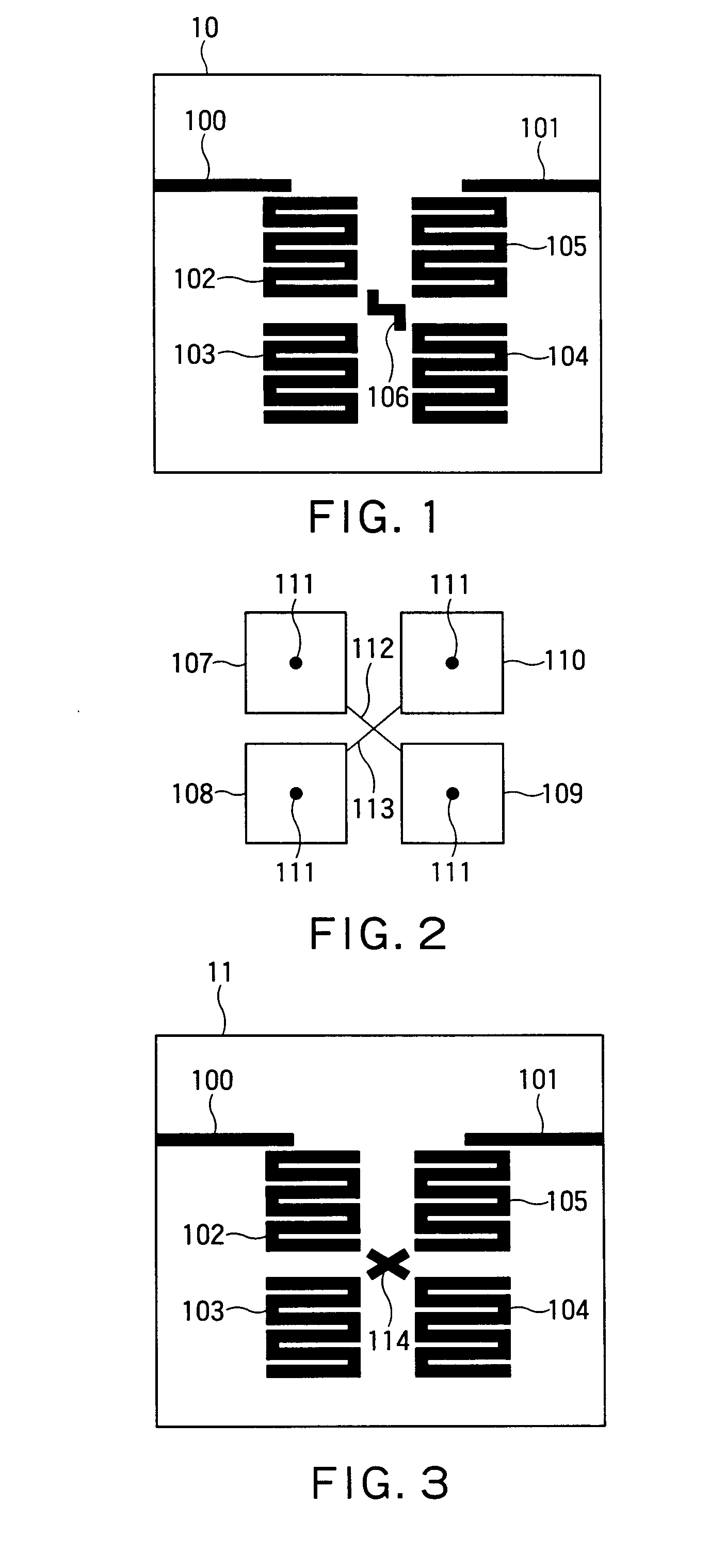Resonant circuit, filter circuit, and antenna device
a filter circuit and antenna technology, applied in waveguides, antenna details, antennas, etc., can solve the problems of deteriorating filter performance or filter cut-off characteristic, difficulty in realizing filter characteristics, and difficulty in taking a sufficient interval between adjacent resonant elements
- Summary
- Abstract
- Description
- Claims
- Application Information
AI Technical Summary
Benefits of technology
Problems solved by technology
Method used
Image
Examples
first embodiment
(1) FIRST EMBODIMENT
[0050]FIG. 1 shows a filter according to a first embodiment. A filter 10 is connected to the feed line by transmission lines of an input section 100 and an output section 101, and has four resonant elements 102, 103, 104 and 105. The resonant element is capable of taking various shapes such as a hairpin shape, an open loop shape, and a spiral shape in addition to a meander line shape as shown in FIG. 1. Further, the input and output sections is able to connect the resonant elements directly.
[0051] The filter 10 has a dense structure formed in such a manner that these resonant elements 102 to 105 are brought close to each other for miniaturization. The respective resonant elements 102 to 105 are constituted by bending an open ends microstrip line, and have an electrical length which is about an integer multiple of a half wavelength within a frequency range from fc−df / 2 to fc+df / 2, which is defined by a center frequency fc and a filter band width df according to a...
second embodiment
(2) SECOND EMBODIMENT
[0068]FIG. 8 shows a filter according to a second embodiment. A filter 60 is connected to the outside by transmission lines of an input section 600 and an output section 601, and is a six-orders filter consisting of six resonant elements 602, 603, 604, 605, 606 and 607. The resonant element has an open loop shape.
[0069] The filter 60 has a dense structure in which these resonant elements 602 to 607 are brought close to each other for miniaturization. The respective resonant elements 602 to 607 are constituted by bending an open ends microstrip line, and have an electrical length which is an integer multiple of a half wavelength within a frequency range from fc−df / 2 to fc+df / 2, which is defined by a center frequency fc and a filter band width df according to a filter specification.
[0070] In a block consisting of four resonant elements 603, 604, 605 and 606 which are selected from the six resonant elements 602, 603, 604, 605, 606 and 607, the four resonant eleme...
third embodiment
(3) THIRD EMBODIMENT
[0078]FIG. 9 shows a filter according to a third embodiment. A filter 70 is connected to the outside by transmission lines of an input section 700 and an output section 701, and is a eight-order filter consisting of eight resonant elements 702, 703, 704, 705, 706, 707, 708 and 709. The resonant element has an elliptic shape, and the filter 70 has a dense structure in which these resonant elements 702 to 709 are brought close to each other. Further, the filter 70 is constituted by two blocks of block 1 which consists of four resonant elements 702, 703, 704 and 705, and block 2 which consists of four resonant elements 706, 707, 708 and 709, and by making the resonant element 705 of the block 1 cascade-connected to the resonant element 706 of the block 2 by the gap coupling.
[0079] In the block 1, the four resonant elements are numbered counterclockwise from the resonant element 702 in the figure such that the resonant element 702 is designated as the first resonant...
PUM
 Login to View More
Login to View More Abstract
Description
Claims
Application Information
 Login to View More
Login to View More - R&D
- Intellectual Property
- Life Sciences
- Materials
- Tech Scout
- Unparalleled Data Quality
- Higher Quality Content
- 60% Fewer Hallucinations
Browse by: Latest US Patents, China's latest patents, Technical Efficacy Thesaurus, Application Domain, Technology Topic, Popular Technical Reports.
© 2025 PatSnap. All rights reserved.Legal|Privacy policy|Modern Slavery Act Transparency Statement|Sitemap|About US| Contact US: help@patsnap.com



